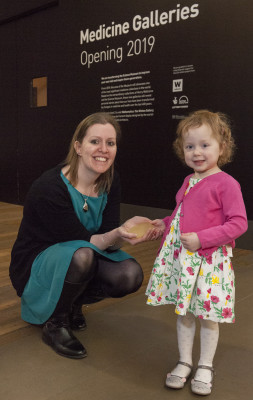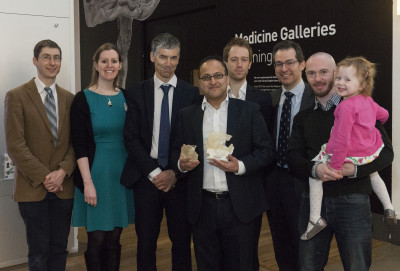Ahead of the opening of our new Medicine Galleries in 2019 the Museum is acquiring a host of fascinating objects that will be on display. Curator Selina Hurley tells us the story behind two such objects, 3D printed models used to plan a kidney transplant.
Each acquisition made to the Science Museum’s collections has its own rich tapestry including the lives of the people involved. When an object enters into the museum as part of the collection, a new chapter begins in that object’s story. Being one of the actors in that story is what makes being a curator a privilege.
During my daily perusal of the BBC news website, I came across the story of a surgeon, who used 3D printed organs to help plan a highly complex transplant between a father and his two-year-old daughter in November 2016. It was the first time 3D printing informed a paediatric kidney transplant between an adult and a child. I then sent an incredibly opportunistic email to Guy’s and St Thomas’ NHS Foundation Trust press team and luckily received an overwhelmingly positive response.
Last week these 3D printed models joined the Science Museum’s permanent collection in a handover with Lucy and Chris Boucher – the father and daughter involved in the transplant, Pankaj Chandak and representatives of Guy’s and St Thomas’ NHS Foundation Trust.

Pankaj Chandak, a transplant registrar, came up with the idea after hearing about the use of 3D printing in cardiac paediatric surgery. Funding for the idea came from the Guy’s and St Thomas’ Charity and in September 2015 Pankaj Chandak and his team had printed the first models; within three months, the first operation took place.
While imaging technologies give surgeons a very good idea about both the donor’s and recipient’s anatomy, sometimes it is not until the surgeon looks inside the body that the full story can be revealed.

Each model took over 10 hours to print. Materials chosen to match the bony, hard pelvis and the much softer structures such as the liver and the sidewalls of the abdomen added texture to the models.
The Boucher family saw the models before their operations to learn more about the procedure. The family have since reported that it helped to put their minds at ease as they were able to visualise the operation: “Seeing the models before Lucy’s transplant helped me to understand what would happen and eased my concerns about the surgery. It was reassuring to know that the surgeons could plan the operation in such detail before it took place.” Although when dealing with complex surgeries it is often difficult for surgeons to define risks for families, as no two cases are the same and this type of surgery is still relatively rare.
Nearly eighteen months on since the transplant, the Boucher family continues to thrive, as Lucy’s father Chris explained – “We never expected such a lovely thing to result from something that began as a dark, horrible experience when Lucy developed heart failure as a baby and then kidney failure, and then needed dialysis treatment until she had her transplant….One of my earliest memories as a young boy was visiting the Science Museum on holiday in London so it’s a bit bizarre that the models of Lucy and I will be on permanent display there. It’s wonderful to think that I’ll still be able to go to the museum to look at the models when I’m an old man.”
In 2016 Pankaj Chandak won the Norman Tanner Medal from the Royal Society of Medicine and the Worshipful Company of Cutlers’ Clarke Medal and Prize for Innovation and now speaks worldwide on the use of 3D printing in complex surgery.
While the story on its own is powerful, these objects also speak to future trends in 3D printing as it is a burgeoning field in science and medicine that holds great promise. Individually tailored 3D printed implants, medical devices and bone or tissue can already be created with the hope for 3D printed organs available for transplant in the not too distant future.
For the time being these models will now reside in our object stores until they go on permanent display in the new Medicine Galleries in 2019.
The Science Museum are grateful to the Wellcome Trust, Heritage Lottery Fund and the Wolfson Foundation, who have generously provided initial leadership funding for the Medicine Galleries.
One comment on “Exploring 3D Printed Organs in the Medicine Galleries”
Comments are closed.
Great innovation , that has revolutionized the transplant surgery towards ease of operating and intraoperative predictabilities.Many congratulations to DR PANKAJ CHANDAK for a noble work .